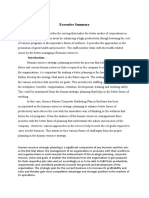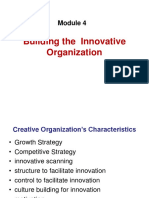0 ratings0% found this document useful (0 votes)
277 viewsStrategy Content and Process Perspective
Strategy Content and Process Perspective
Uploaded by
kartik samaiya-1. The document discusses content strategy and its importance in creating a structured plan for developing useful content to achieve business goals. It outlines the key steps in a content strategy model including setting goals, research, developing media tactics, and testing.
2. It then discusses the importance of having a strategic perspective when making business decisions. Taking a strategic view considers all business objectives and how potential decisions impact priorities.
3. The last section summarizes a study on the relationship between marketing strategy and performance in export ventures. The study found export marketing strategy, competence, and managerial commitment are key determinants of export performance.
Copyright:
© All Rights Reserved
Available Formats
Download as PPTX, PDF, TXT or read online from Scribd
Strategy Content and Process Perspective
Strategy Content and Process Perspective
Uploaded by
kartik samaiya-0 ratings0% found this document useful (0 votes)
277 views21 pages1. The document discusses content strategy and its importance in creating a structured plan for developing useful content to achieve business goals. It outlines the key steps in a content strategy model including setting goals, research, developing media tactics, and testing.
2. It then discusses the importance of having a strategic perspective when making business decisions. Taking a strategic view considers all business objectives and how potential decisions impact priorities.
3. The last section summarizes a study on the relationship between marketing strategy and performance in export ventures. The study found export marketing strategy, competence, and managerial commitment are key determinants of export performance.
Original Title
STRATEGY CONTENT AND PROCESS PERSPECTIVE
Copyright
© © All Rights Reserved
Available Formats
PPTX, PDF, TXT or read online from Scribd
Share this document
Did you find this document useful?
Is this content inappropriate?
1. The document discusses content strategy and its importance in creating a structured plan for developing useful content to achieve business goals. It outlines the key steps in a content strategy model including setting goals, research, developing media tactics, and testing.
2. It then discusses the importance of having a strategic perspective when making business decisions. Taking a strategic view considers all business objectives and how potential decisions impact priorities.
3. The last section summarizes a study on the relationship between marketing strategy and performance in export ventures. The study found export marketing strategy, competence, and managerial commitment are key determinants of export performance.
Copyright:
© All Rights Reserved
Available Formats
Download as PPTX, PDF, TXT or read online from Scribd
Download as pptx, pdf, or txt
0 ratings0% found this document useful (0 votes)
277 views21 pagesStrategy Content and Process Perspective
Strategy Content and Process Perspective
Uploaded by
kartik samaiya-1. The document discusses content strategy and its importance in creating a structured plan for developing useful content to achieve business goals. It outlines the key steps in a content strategy model including setting goals, research, developing media tactics, and testing.
2. It then discusses the importance of having a strategic perspective when making business decisions. Taking a strategic view considers all business objectives and how potential decisions impact priorities.
3. The last section summarizes a study on the relationship between marketing strategy and performance in export ventures. The study found export marketing strategy, competence, and managerial commitment are key determinants of export performance.
Copyright:
© All Rights Reserved
Available Formats
Download as PPTX, PDF, TXT or read online from Scribd
Download as pptx, pdf, or txt
You are on page 1of 21
STRATEGY CONTENT AND
PROCESS PERSPECTIVE &
MARKETING STRATEGY-
PERFORMANCE RELATIONSHIP
SUBMITTED TO : DR. SONALI BHANDARI JAIN
BY: KARTIK SAMAIYA
M.COM 2 ND SEMESTER
ROLL NO-901014
INTRODUCTION
1. Content Strategy provides a consistent plan that
increases the productivity of content creators and
producers.
2. Because it outlines just how content should be managed
from the beginning of a project to the end.
3. This is achieved through a process of creating goals,
analyzing and researching, determining how to create
and produce content, and testing the final products.
4. Content Strategy provides a road map for creators to
follow which helps them create more meaningful
content.
WHAT IS CONTENT STRATEGY?
Content Strategy is planning for the creation, delivery and governance or useful,
usable content.
More simply put, content strategy is a plan that creates a structure for the
gathering, creating, producing, and editing of a message.
Content Strategy is not the actual process for creating content, but a focused
strategy that provides an outline for the creation of content.
This system streamlines the creation of messages by helping people establish a
routine that helps them focus more on creating the message rather than on how
they are going to create it.
The process all begins with the message. The message is conveyed through the
content that is produced, and it is very important to make sure those messages
are meaningful.
Content Strategy is not just for one-time messages. It is applied to
a project like a website or a business brand, which have
continuing content cycles.
A basic content cycle consists of research, creation,
optimization, publication, promotion, and measurement.
Content Strategy is the plan created to manage this process. In
essence, it’s a plan that manages a plan.
The structure of a Content Strategy helps to bring the focused
message to the forefront so creators and producers can always
have the end goal in mind during the creation and production
cycle.
IS CONTENT STRATEGY REALLY
IMPORTANT?
“Content must be expressly designed and developed so
as to address specific business objectives.”
Content Strategy is not just the creation of a robotic
plan that will spit out the required content with less
effort. A content strategy is created with the specific
goal of the content in mind.
Content Strategy provides the map to show how the
various forms of content produced will help achieve
the end objective or goal.
Content Strategy does require more time and resources
in the beginning, but it actually makes the content more
likely to succeed. The map that it provides ensures that the
message helps in getting to the end destination of the goal.
The more creators know about what they need to do and
where their content needs to go, the better they’re able to
execute that plan and achieve the end goal.
THE CONTENT STRATEGY MODEL
The following is a modified Content Strategy Model
that shows the basic steps that a content strategy
plans.
1. Goals
2. Analysis and Research
3. Media Tactics
4. Testing.
Goals : What do you want to say?
The first step in creating a content strategy is having a
specific goal in mind . What message do you want to
convey to your audience? The goals you define should
encompass the whole idea, brand, or company image
you want to convey.
They need to be specific and measurable. When
content is created and produced with those specific
goals in mind, the message of the content contributes
to achieving the overall goal.
Analysis and Research : Is your audience
listening?
The second step in creating a content strategy is
assessing the current situation. What content already
exists and what does your audience know about it?
What strategies have been used in the past? You need
to be sure to understand where this past information
came from and how it was gathered.
For example, information could have come from
interviews with experts or research on how people
responded to the information they were presented
with.
Media tactics: How will you deliver your
message?
The main goal of Content Strategy is maintaining a focus for
the messages created by your business.
The fourth step is determining how you will evaluate your
content. Once you have delivered your content to your
audience, how will you know that your audience is responding
to your messages? Will you analyze the daily views of a website
after you deliver your content? Or will you have direct user
feedback that tells you exactly what is and isn’t working in your
content?
How is your audience responding? Is the response the result
you were looking for? If not , how can it be improved?
These are similar questions to the ones that should
be asked in the research portion of a content strategy.
Testing is an essential part of the model be cause it
provides research that can be used to edit and refine the
content you’ve already produced and the content you will
create in the future.
With a model in place as a guide, it is much easier to stay
focused when the creation of content is in full swing. That
model can also help determine how to manage the content
after it has been created.
The main goal of Content Strategy is maintaining a focus
for the messages created by your business
What is Strategic Perspective?
In business, your strategic perspective determines how
your company views and solves important issues.
Putting the word "strategic" before the word
"perspective" indicates a tactical, carefully formulated
approach.
But, if you discuss a market withdrawal from a
strategic perspective, you will consider the possibilities
in light of your predetermined business objectives. You
exercise an enlightened process, exploring how the
withdrawal affects your business's priorities.
Perspective Is Needed
Understanding the significance of a business's strategic
perspective invariably encourages business leaders to create a
stronger strategic perspective in hopes of making better decisions.
Carefully consider the past, present and future of your business
objectives. Once senior management clearly envisions its goals
and objectives, it makes better decisions in all area setter
decisions.
This can be applied to many aspects of decision making. But,
staying with the marketing example for now, establishing clear
goals allows effective, profitable marketing decisions -- for
developing a branding strategy, generating growth and other key
issues. All decisions are viewed within the perspective of your
most important goals.
The Strategic Thinking Process
A strategic perspective, formulated by strategic thinkers,
puts information into its proper context so it resonates with
insight that is relevant to the business's objectives. With the
proper perspectives, business analysis results in sometimes-
powerful conclusions.
Because a business often has many goals and objectives,
thinking from a strategic perspective takes all the goals into
account, meaning the strategic thinker must consider
multiple perspectives. He must juggle objectives of all sorts
-- not just a single, overriding objective.
Perspective
Visualize a square drawn on a piece of paper. If an artist
added a few more strokes to the page, the square becomes
a cube.
Suddenly, it has depth, height and width as viewed from
a certain vantage point. As a business makes decisions, it
has to do more than crunch numbers.
Strategic perspectives view a challenge in such a way that
succeeds in reaching business goals. Viewing business
challenges from multiple perspectives allows the decision
maker choices in light of the way each optional solution
relates to the next when viewed side-by-side -- like two-
dimensional cubes.
Digital Intelligence Perspective
As the Business Centre website states, the way we
gather information about our business and its
competitors today has moved to digitally interactive,
customer-driven sources such as social media.
Business Centre predicts that with customer input
from social media, the business's customers will
increasingly drive business decision making. A wise
business today will not ignore customers with such a
public platform. Therefore, one strategic perspective
for many businesses is the digital intelligence
perspective.
MARKETING STRATEGY-PERFORMANCE
RELATIONSHIP
The relationship between marketing strategy and performance has
been well documented in the domestic marketing context.
However, empirical work in the context of export marketing has
been fragmented. The authors investigate the marketing strategy-
performance relationship in the context of export ventures.
The study differs from previous export marketing studies in that
(1) a comprehensive set of potential determinants of export market
performance is considered;
(2) The unit of analysis is the individual product-market export
venture, rather than the firm or a business division; and
(3) The analysis is based on in-depth personal interviews.
The authors propose a conceptual framework of export
marketing strategy and performance and test it by path
analysis.
The results support the contention that export marketing
strategy, firm's international competence, and managerial
commitment are the key determinants of export
performance.
Export marketing strategy is influenced by internal (firm
and product characteristics) and external factors (industry
and export market characteristics).
They then discuss implications for management and
further research.
THE END
THANK YOU
You might also like
- Multiple Choice: Chapter 9: Responsibility Accounting and DecentralizationDocument43 pagesMultiple Choice: Chapter 9: Responsibility Accounting and Decentralizationquanghuymc100% (2)
- Core Technologies in An Effective IT SystemDocument2 pagesCore Technologies in An Effective IT SystemRWA19750% (1)
- User Manual Developer Portal Manual Version 3Document96 pagesUser Manual Developer Portal Manual Version 3Janagar SundaramoorthyNo ratings yet
- Case Study of SolomaneDocument2 pagesCase Study of SolomaneCyb. Sec.100% (5)
- It Can Wait OverviewDocument61 pagesIt Can Wait Overviewjmmcdermott100% (1)
- SPMS Lgu Trinidad BoholDocument26 pagesSPMS Lgu Trinidad BoholJoemar Cafranca100% (3)
- Business Plan Evaluation FormDocument5 pagesBusiness Plan Evaluation Formvhle67No ratings yet
- Strategy For Justice ICT 2007-2010 - Ministry of Justice MacedoniaDocument47 pagesStrategy For Justice ICT 2007-2010 - Ministry of Justice MacedoniaHarumNo ratings yet
- Session 7 - Display Marketing PDFDocument49 pagesSession 7 - Display Marketing PDFshagun jalanNo ratings yet
- The Relevance of Sales Promotion To Business OrganizationsDocument40 pagesThe Relevance of Sales Promotion To Business OrganizationsJeremiah LukiyusNo ratings yet
- Excellence in Public Relations and Communication Management, James E. Grunig, Sveuciliste Maryland, SADDocument32 pagesExcellence in Public Relations and Communication Management, James E. Grunig, Sveuciliste Maryland, SADgaldonadelaNo ratings yet
- Vision, Mission and Planning CycleDocument215 pagesVision, Mission and Planning CyclePalwasha Khan100% (5)
- HB 278-2009 Recordkeeping ComplianceDocument7 pagesHB 278-2009 Recordkeeping ComplianceSAI Global - APACNo ratings yet
- The Marketing Department Is in Charged To Create The PlanDocument3 pagesThe Marketing Department Is in Charged To Create The PlanSofia CastelliNo ratings yet
- Social Media and Web Analytics Unit-5Document10 pagesSocial Media and Web Analytics Unit-5NAUSHAD SHEKHNo ratings yet
- Jansen Website AnalysisDocument22 pagesJansen Website AnalysisParthNo ratings yet
- Zalando Insights BrandPartner Study 2020Document36 pagesZalando Insights BrandPartner Study 2020João Tiago Martins Girão100% (1)
- Creative Competitive Intelligence A Complete Guide - 2020 EditionFrom EverandCreative Competitive Intelligence A Complete Guide - 2020 EditionNo ratings yet
- Current Issue and MarketingDocument5 pagesCurrent Issue and Marketingzuraidah hashimNo ratings yet
- BUS 5112 Portfolio Assignment Unit 2Document6 pagesBUS 5112 Portfolio Assignment Unit 2Raju SobhanNo ratings yet
- Branding & Priority BankingDocument42 pagesBranding & Priority BankingGAUTAM BUCHHANo ratings yet
- Advertising ProjectDocument125 pagesAdvertising Projectkunal181287No ratings yet
- Online Customer Engagement ManagementDocument12 pagesOnline Customer Engagement ManagementEric PrenenNo ratings yet
- Voice of Customer 2.0: Social, Agile and Integrated: Bob Thompson Ceo, Customerthink Corp. March 2010Document7 pagesVoice of Customer 2.0: Social, Agile and Integrated: Bob Thompson Ceo, Customerthink Corp. March 2010Michael O RourkeNo ratings yet
- Best Practices Securing EcommerceDocument64 pagesBest Practices Securing Ecommercejunior_00No ratings yet
- Marketing Strategy and Empathy PDFDocument16 pagesMarketing Strategy and Empathy PDFHope100% (3)
- Com3705 DEVIANCE PDFDocument325 pagesCom3705 DEVIANCE PDFAnonymous AvG4TzCNo ratings yet
- How To Plan Your BusinessDocument11 pagesHow To Plan Your BusinessyonghalzNo ratings yet
- RFP IntranetDocument9 pagesRFP IntranetashuokNo ratings yet
- Venturekit Business PlanDocument129 pagesVenturekit Business PlanHoàiThươngNo ratings yet
- UNIT-3 Ecommerce MaterialDocument11 pagesUNIT-3 Ecommerce Materialvarshu5760No ratings yet
- Exploring The Impact of Knowledge Management KM Best Practices For Project Management Maturity Models On The Project Management Capability ofDocument7 pagesExploring The Impact of Knowledge Management KM Best Practices For Project Management Maturity Models On The Project Management Capability ofDarlingtonGwenhureNo ratings yet
- Marketing Strategy - An OverviewDocument91 pagesMarketing Strategy - An Overviewsalman200867No ratings yet
- Digital Marketing For PhysiotherapistsDocument10 pagesDigital Marketing For PhysiotherapistsHapca IleanaNo ratings yet
- The Effect of Brand Credibility On Consumers Brand Purchase Intention in Emerging Economies - The Moderating Role of Brand Awareness and Brand ImageDocument13 pagesThe Effect of Brand Credibility On Consumers Brand Purchase Intention in Emerging Economies - The Moderating Role of Brand Awareness and Brand ImageWaqas Saleem MirNo ratings yet
- Media Planning Revised NotesDocument70 pagesMedia Planning Revised Notesbs3535696No ratings yet
- Brand Reputation Final PresentationDocument18 pagesBrand Reputation Final PresentationPrateek NilkundNo ratings yet
- 3.19. Web Analytics. How To Evaluate The ResultDocument19 pages3.19. Web Analytics. How To Evaluate The ResultfuadaliyevNo ratings yet
- Research ReportDocument71 pagesResearch ReportSuraj DubeyNo ratings yet
- Ateh Rhessa History of MS OfficeDocument9 pagesAteh Rhessa History of MS Officeulonggwapo2No ratings yet
- CB&MC Media StrategiesDocument16 pagesCB&MC Media Strategiesmukul dish ahirwarNo ratings yet
- ROI Study MethodologyDocument28 pagesROI Study MethodologyOpe Jegede100% (1)
- Business Plan Project Student TemplateDocument14 pagesBusiness Plan Project Student TemplateHy Lau100% (1)
- Lin RodnitzkyDocument15 pagesLin RodnitzkyLya OchoaNo ratings yet
- EchoSign API GuideDocument7 pagesEchoSign API GuideKathy LewisNo ratings yet
- DA Project ReportDocument17 pagesDA Project Reportkirti reddyNo ratings yet
- Marketing CommunicationsDocument24 pagesMarketing CommunicationsHarish KumarNo ratings yet
- Unit 24 Digital Marketing SkeletonDocument9 pagesUnit 24 Digital Marketing SkeletonAsghar Ali Qureshi0% (1)
- Ict Strategy Formulation-A Case Study of Insurance CompanyDocument11 pagesIct Strategy Formulation-A Case Study of Insurance CompanySmilka Janeska-SarkanjacNo ratings yet
- Central Australian College Hobart, Tasmania: BSBSLS501 Develop A Sales PlanDocument32 pagesCentral Australian College Hobart, Tasmania: BSBSLS501 Develop A Sales PlannehaNo ratings yet
- Distribution Channels PresentationDocument15 pagesDistribution Channels PresentationLaabella100% (1)
- BI Assi 3Document36 pagesBI Assi 3Shaku MakuNo ratings yet
- ARB OutofHome AdvertisingDocument18 pagesARB OutofHome AdvertisingmanchanrNo ratings yet
- Kudos Technology Services Nigeria Limited Company ProfileDocument11 pagesKudos Technology Services Nigeria Limited Company Profileinfo5823No ratings yet
- SWOT AnalysisDocument16 pagesSWOT Analysisrizwansaeed73No ratings yet
- Requirements Elicitation For Mobile B2B Applications: A Project-Based Consulting ApproachDocument22 pagesRequirements Elicitation For Mobile B2B Applications: A Project-Based Consulting ApproachUdoNo ratings yet
- Research Proposal For Effectiveness of Online MarketingDocument12 pagesResearch Proposal For Effectiveness of Online MarketingSamina PachaNo ratings yet
- Teaching Language-Learning StrategiesDocument6 pagesTeaching Language-Learning StrategiesviviNo ratings yet
- Vở ghi quản trị (QTRE303)Document65 pagesVở ghi quản trị (QTRE303)k62.2312790045No ratings yet
- Human Values Questions & Answers LongDocument80 pagesHuman Values Questions & Answers LongSuyash SinghNo ratings yet
- The Sustainable Managementofa Tourism Destinationin Ireland AFocuson County ClareDocument27 pagesThe Sustainable Managementofa Tourism Destinationin Ireland AFocuson County ClarerajyamgarNo ratings yet
- Case StudyDocument5 pagesCase StudygurlalNo ratings yet
- OPSP GuideDocument19 pagesOPSP GuideKen CruzNo ratings yet
- Analyzing Customer Satisfaction by Using 5 Dimension SERVQUAL Model in The Content of E-Banking Service Quality of The DBLDocument59 pagesAnalyzing Customer Satisfaction by Using 5 Dimension SERVQUAL Model in The Content of E-Banking Service Quality of The DBLAkshat Singh Thakuri100% (1)
- CHN ReviewerDocument12 pagesCHN ReviewerArvi GayeNo ratings yet
- Management Training and DevelopmentDocument20 pagesManagement Training and DevelopmentMeerabhai PPNo ratings yet
- Managerial EconomicsDocument4 pagesManagerial EconomicsVMinKook biasNo ratings yet
- Bms - Unit 2 - HandoutDocument18 pagesBms - Unit 2 - HandoutSwathiNo ratings yet
- Department of Road 2010-13Document32 pagesDepartment of Road 2010-13Ramesh PokharelNo ratings yet
- Apollo 13 A Leadership Movie: ULDP Lesson PlanDocument13 pagesApollo 13 A Leadership Movie: ULDP Lesson PlanHiren PatelNo ratings yet
- HRM AssignmentDocument14 pagesHRM AssignmentSteparies Martin100% (15)
- Organization & Management: First Semester - First Quarter Week - 1Document9 pagesOrganization & Management: First Semester - First Quarter Week - 1Mira Joey AradoNo ratings yet
- Module 4 Building The Innovative OrganizationDocument49 pagesModule 4 Building The Innovative OrganizationBruno SaturnNo ratings yet
- Cbmec 213 Lecture.Document4 pagesCbmec 213 Lecture.Beatriz DolozonNo ratings yet
- Talent Management - Competency Development: Key To Global LeadershipDocument15 pagesTalent Management - Competency Development: Key To Global LeadershipBvvss RamanjaneyuluNo ratings yet
- Problem Analysis and LFADocument9 pagesProblem Analysis and LFAMary KishimbaNo ratings yet
- BSC (2021) Saudi Arabia - DipakeDocument15 pagesBSC (2021) Saudi Arabia - DipakeCINTA ADILIA PUTRI LARASATINo ratings yet
- NURSING LEADERSHIP AND MANAGEMENT LECTURE WORKSHEET On PLANNINGDocument5 pagesNURSING LEADERSHIP AND MANAGEMENT LECTURE WORKSHEET On PLANNINGjanna mae patriarcaNo ratings yet
- Human Resourse Management Project ON Dubai Taxi CorporationDocument19 pagesHuman Resourse Management Project ON Dubai Taxi CorporationVanessa_Dsilva_1300No ratings yet
- Session 8 Quest For Meaning and FulfilmentDocument4 pagesSession 8 Quest For Meaning and FulfilmentKriti RajNo ratings yet
- PerDev - Q2 - Module 5 Insights Into Ones Personal Development EDITEDDocument23 pagesPerDev - Q2 - Module 5 Insights Into Ones Personal Development EDITEDjovelou.marticioNo ratings yet
- The Contingency Theory of Management AccountingDocument16 pagesThe Contingency Theory of Management AccountingMarthyn Maturbongs100% (1)

























































































